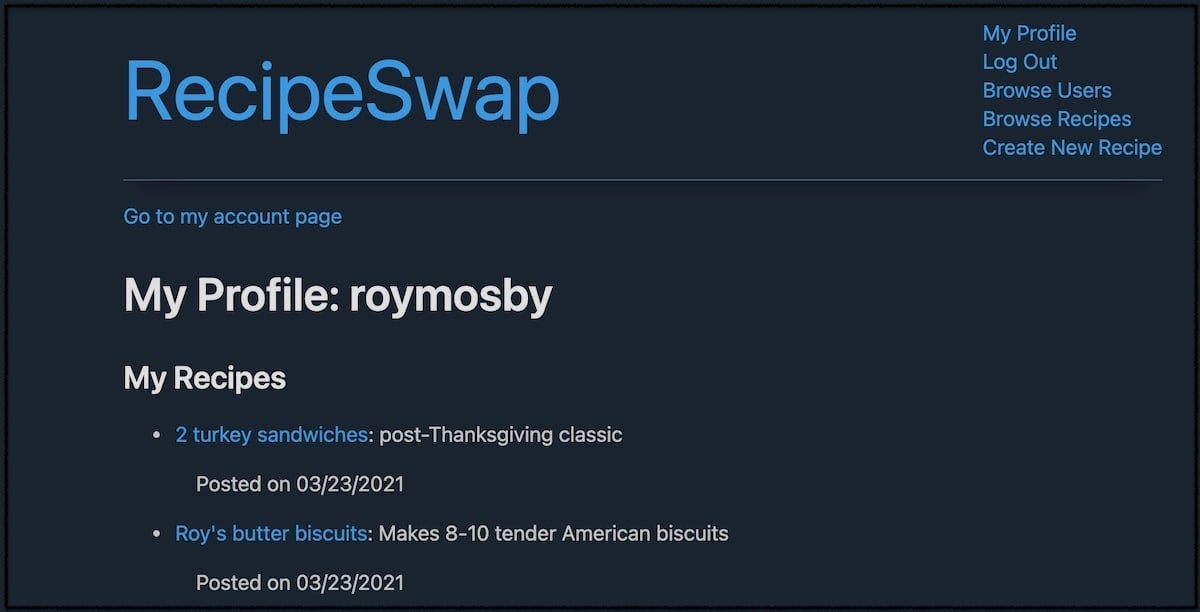Dealing with multiple table relations
Published: Sun, Feb 14, 2021
"And all the men and women merely players; They have their exits and their entrances, And one man in his time plays many parts..." -Shakespeare, As You Like It

RecipeSwap demo on Heroku (not mobile friendly)
RecipeSwap, a Ruby project built with Sinatra and ActiveRecord for my Flatiron class, is a recipe sharing community. Users of the RecipeSwap can create recipes and curate other's recipes by favoriting them. Before going any further, this article assumes familiarity with Ruby and basic structured database concepts.
Object Relation Model
To design my object relation model, I have to consider two types of data in RecipeSwap: users and recipes. I also have to determine how those two types relate to each other. On one hand, I have users who post recipes. A recipe can only be authored by one user. On the other hand, I have users that can favorite recipes. A recipe can be favorited by any number of users. Like Shakespeare's players, I have to get user and recipe each to play more than one part.
These roles in database relational terms:
userHAS MANYrecipesandrecipeBELONGS TOuseruserHAS MANYrecipesandrecipeHAS MANYusers
BUT WAIT! That is confusing! How can these relations be differentiated? It is ambiguous to the user and it would cause my program to fail. Something has to be re-named. To give the second relation more context, I am going to think re-word them as:
userHAS MANYrecipesandrecipeBELONGS TOusercollectorHAS MANYfavoritesandfavoriteHAS MANYcollectors
Much better!
Relation #1: One-to-Many
The first relation is one-to-many. The database tables can be associated by placing a foreign key to the user on the recipe. This foreign key is a reference on the recipe's record back to the user record to identify who owns it. The ActiveRecord migration files that establish the tables in my database looks similar to the code below:
#create_user migration...
class CreateUser < ActiveRecord::Migration
def change
create_table :users do |t|
t.string :email
t.string :username
t.string :password_digest
end
end
end
#create_recipe migration...
class CreateRecipe < ActiveRecord::Migration
def change
create_table :recipes do |t|
t.string name
t.string description
t.string ingredients
t.string instructions
t.integer servings
t.integer user_id #foreign key for user
t.datetime created_at
t.datetime updated_at
end
end
endWhen working with ActiveRecord, the second half of establishing a working object-relational model is to create Ruby classes to represent each one of the tables. These classes are used to build associations with each other to allow the programmer to work with the application's data without needing to leave the Ruby programming language. The database tables and the model classes make up the "Model" in Model View Controller (MVC) architecture. The code below shows my model classes.
# user model in "model.rb"
class User < ActiveRecord::Base
has_many :recipes
has_secure_password # don't focus on this...
# it forces a user to have a password
# and stores it securely.
end
# recipe model in "recipe.rb"
class Recipe < ActiveRecord::Base
belongs_to :user
endRelation #2: Many-to-Many
As I previously discussed, I chose to think of the many-to-many relation as collectors and favorites. This differentiates itself from the first relationship. Several steps have to be completed e to get ActiveRecord and the database to understand this new relation.
As with all many-to-many relations, I will need a join table. A join table brings together foreign keys from records on two separate tables and creates s a record to represent that relationship. This allows the database to make many collector-favorite connections. Following ActiveRecord convention, this table is named collector_favorites as shown below.
class CreateCollectorFavorites < ActiveRecord::Migration
def change
create_table :collector_favorites do |t|
t.integer :collector_id, foreign_key: {to_table: 'users'}
t.integer :favorite_id, foreign_key: {to_table: 'recipes'}
end
end
endActiveRecord Naming Conventions
There is much more going on with this migration file than with the previous users and recipes tables. Much of the magic in Active Record comes from naming conventions. Through consistent naming, ActiveRecord can tie together different files with database tables without much effort on the developer's part. The following are basic ActiveRecord naming guidelines:
- a record on a table is a singular noun:
userorrecipe - a table's name is a pluralized version of the records' name:
usersorrecipes - a foreign key is on a table is singular and has a "_id" appended:
user_idorrecipe_id - the model class is singular and uses PascalCase:
UserorRecipe - the filenames containing the classes must be singular and in lowercase or snake_case:
user.rborrecipe.rb - in a one-to-many relationship
- the class that is the one in one-to-many declares its ownership of the other:
has_many :recipes - the class that is the many in one-to-many declares its owner by using:
belongs_to :user
- the class that is the one in one-to-many declares its ownership of the other:
- join table used by many-to-many relationship (we will get to the name changes shortly...)
- join table name is the singular name of the first table and the pluralized name of the second table combined with an underscore:
collector_favorites. Which table comes first is a matter of developer preference. - the foreign keys are singular and have "_id" appended:
collector_idandfavorite_id - The model class combines the singular names of both joined tables using PascalCase:
CollectorFavorite - The file containing each model class uses snake_case:
collector_favorites.rb(same name as database table plus file extension) - The model classes each declare ownership of the join table:
has_many :collectors(this is a bit incomplete but I promise we will get to renaming in just a moment!) - The join table model then declares its relation to the other two models:
belongs_to :collectorandbelongs_to :favorite - The both original model classes finally declare ownership of eachother through the join table:
has_many :collectors, through: :collector_favoritesandhas_many :favorites, through: :collector_favorites
- join table name is the singular name of the first table and the pluralized name of the second table combined with an underscore:
Renaming Relationship Keywords
Here is the model code that I will be working with that make the second relationship work alongside the first:
#user model
class User < ActiveRecord::Base
has_many :recipes
has_many :collector_favorites, foreign_key: "collector_id"
has_many :favorites, class_name: "Recipe", through: :collector_favorites
has_secure_password
end
#collector_favorites model
class CollectorFavorite < ActiveRecord::Base
belongs_to :collector, class_name: "User"
belongs_to :favorite, class_name: "Recipe"
end
#recipe model
class Recipe < ActiveRecord::Base
belongs_to :user
has_many :collector_favorites, foreign_key: "favorite_id"
has_many :collectors, class_name: "User", through: :collector_favorites
endHere is the join table migration again...
class CreateCollectorFavorites < ActiveRecord::Migration
def change
create_table :collector_favorites do |t|
t.integer :collector_id, foreign_key: {to_table: 'users'}
t.integer :favorite_id, foreign_key: {to_table: 'recipes'}
end
end
endLet's focus on the join table first. It consists of 3 keys. First, an id key that ActiveRecord automatically makes so is not defined. The remaining two keys, collector_id and favorite_id are foreign keys to users and recipes respectively. Since they do not match the ActiveRecord naming conventions, we have to give some extra information. The additional argument, foreign_key: {to_table: 'XXXXXX') is a hash that lets ActiveRecord know that this key, regardless of its name, is being used as a foreign key for "XXXXXX" table.
The next step to making the collector_favorites table is to create the model class, CollectorFavorite. As an object that represents a join table, this uses belongs_to twice to associate it to collector and favorite. ActiveRecord would normally look for a collectors and favorites table but this is not what I want. So that it looks for the correct objects, I include their name as a value for the hash, class_name: ...foreign_key: {to_table: 'users'} and ...foreign_key: {to_table: 'recipes'}.
I now need to do some work on the User and Recipe objects to finalize the association. When creating associations through a join table, I often think about the processes as "walking through" through my model until I get to my destination object.
On each, User and Recipe, I declare the association has_many :collector_favorites. It is here I also define the name of the foreign key associated with this part of my model. In other words, I am telling ActiveRecord that I want user_id to be known as collector_id and recipe_id to be known as favorite_id. This allows the current association to coexist with the first.
The final step on the "walk" through the model in creating the many-to-many association between the two destination objects. Each has a has_many relation to the other but refers to them through collectors and favorites. Since neither of these is a table in our database, we have to tell ActiveRecord what classes we are referring to. This is done through the class_name: hash. I also have to tell it that these associations are made through: :collector_favorites.
It was quite a journey to make two associations work independently on the same tables. By renaming the resources in one relation, RecipeSwap users can make recipes and favorite them too. Like Hamlet said, "Suit the action to the word, the word to the action..."

I'm open to work!
- Hi all! I am seeking a remote engineer position that can leverage a unique history of IT experience with several years of developing web applications.
- I've worked most recently with JavasScript, TypeScript, Python, PHP, and Ruby but am game to learn other scripted languages.
- Most importantly, I am all about making positive impact at organizations that see inclusivity as a strength rather than an obligation.
If you have room on your team and need someone that can contribute beyond just code, hit me up!


